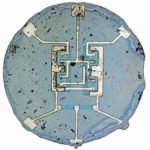FM radio gets an upgrade, the U.S. goes back to the moon, and a popular video sharing site is born. It all happened This Week in Tech History.
This week in 1961 – The FCC, The Federal Communications Commission gave their approval for FM radio stations in the US to begin broadcasting in stereo sound. Up to that point, all FM radio stations, like their AM counterparts, broadcast in mono
That same week – Robert Noyce received a patent for an integrated circuit – or microchip, that he developed alongside Jack Kilby. Seven years later, Noyce would team up with Gordon Moore to form a company called NM Electronics, ultimately becoming Intel.
In 1967 – Soyuz 1, a manned spaceflight carrying Soviet cosmonaut Vladimir Komarov was launched into orbit. The next day, Komarov would become the first human to die during a space mission when the capsule’s parachute failed to open.
This week in 1972 – The Apollo 16 Lunar Module, commanded by John Young and piloted by Charles Duke, landed on the moon. The module enjoyed a three-day stay on the moon and the crew spent a total of 20 hours and 14 minutes exploring the surface of the moon.
1977 – Fiber optic cables were first used to carry live telephone traffic. Optical communication began way back in the 1790s with the invention of the optical semaphore telegraph. Today, more than 80 percent of long distance telephone and data traffic is carried over fiber optic cables.
And this week in 2005 – The first ever YouTube video was uploaded by co-founder Jawed Karim. The 19-second video, titled “Me at the zoo”, was shot by his high school friend at the San Diego Zoo in front of the elephant exhibit. Today, about 300 hours of video are uploaded to YouTube every minute.







